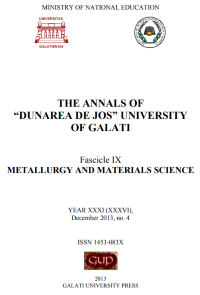Evaluation of the Occupational Risk Associated to Work Environment In Ferrous Metallurgy
Abstract
Work environment present risk factors due to chemical pollution of ambient air with dust, smoke, fumes, vapors, mists and gases. Moreover physical risk factors (related to noise, lighting, temperature, vibration, humidity, radiation) lead to hazards with varying degrees of significance. In this paper were identified the hazards associated with the work place for a maintenance worker who works in all sectors of metallurgical plant. The risk assessment was made in terms of severity and probability, combining these two factors in a risk matrix. From the analysis the significant hazards (unacceptable) related to work environment resulted. These are caused by the presence of the following pollutants: toxic gases (VOCs, PAHs, dioxins, furans), explosive flammable gases (methane gas, blast furnace gas, bigaz, oxygen), carbon monoxide and particulate matter.
Downloads
References
[2]. Ozunu A., Anghel C. I. - Evaluarea riscului tehnologic şi securitatea mediului, Editura Accent, Cluj-Napoca, 2007.
[3]. *** - European Commission. 2000. Reference Document on Best Available Techniques for the Production of Iron and Steel. BAT Reference Document (BREF). European IPPC Bureau, Seville, Spain. eippcb.jrc.es.
[4]. *** - Sustainability Report of the world steel industry,2008, http://www.worldsteel.org.
[5]. *** - Hazard Prevention and Control in the Work Environment, World Health Organization, Geneva, August 1999, http://www.who.int.
[6]. *** - National Emission Standards for Hazardous Air Pollutants: Integrated Iron and Steel Manufacturing: Final Rule. 40 CFR Part 63, Federal Register 68:97. EPA, 2003, Washington, D.C. www.epa.gov.
[7]. Alvarez F., et.al. - Physical speciation of arsenic, mercury, lead, cadmium and nickel in inhalable atmospheric particles, Analytica Chimica Acta 524, 2004, p. 33-40.
[8]. Popescu L.G., Manea D., Savin D. - Compuși organici volatili. caracteristici fizico-chimice, efecte asupra mediului și sănătății umane, măsuri de control poluare atmosferică, Gepropol 2009, p. 282.
[9]. Chang E.E., et.al. - Health risk assessment of exposure to selected volatile organic compounds emitted from an integrated iron and steel plant, Inhalation Toxicology, December 2010, Vol. 22, No. S2: p. 117-125.
[10]. Van den Berg et.al. - The 2005 world health organization reevaluation of human and mammalian toxic equivalency factors for dioxins and dioxin-like compounds. Toxicological Sciences, 2006, p. 223-241.
[11]. *** - SR EN 292-1/1996.



